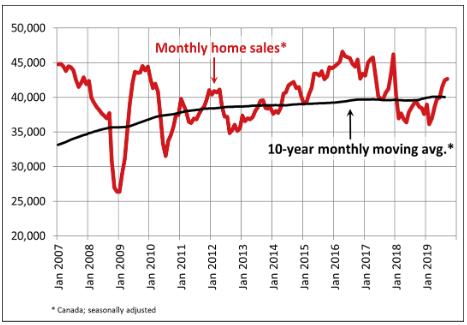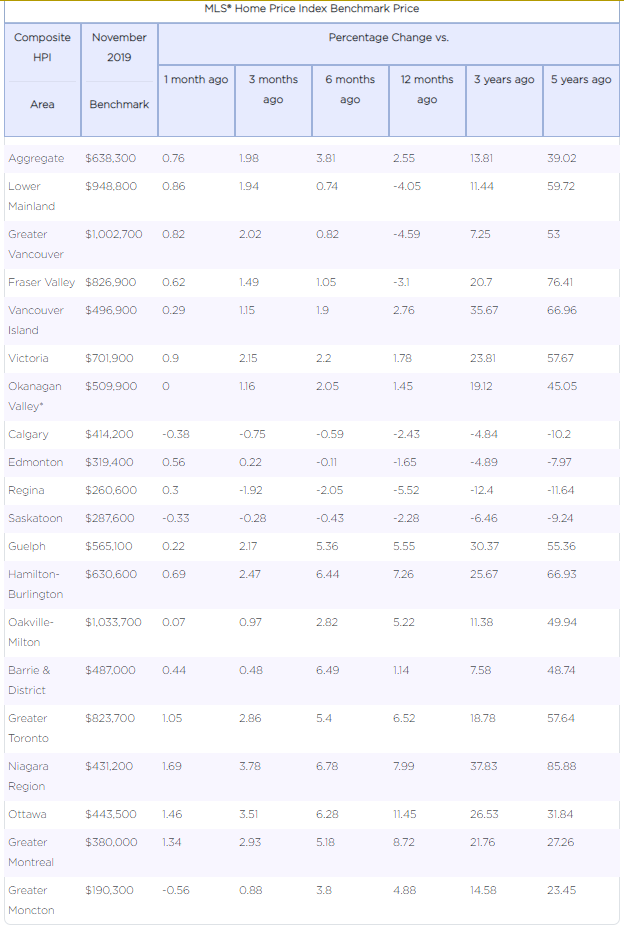NOVEMBER DATA CONFIRM CANADIAN HOUSING REBOUND
 Statistics released today by the Canadian Real Estate Association (CREA) show that national home sales rose for the ninth consecutive month and now stands a full 20% above the six-year low reached in February 2019. While the chart below shows that monthly home sales are now well above their 10-year average, they remain 6%-to7% below the record pace posted in 2016 and 2017.
Statistics released today by the Canadian Real Estate Association (CREA) show that national home sales rose for the ninth consecutive month and now stands a full 20% above the six-year low reached in February 2019. While the chart below shows that monthly home sales are now well above their 10-year average, they remain 6%-to7% below the record pace posted in 2016 and 2017.
There was an almost even split between the number of local markets where activity rose and those where it declined. Higher sales across much of British Columbia and in the Greater Toronto Area (GTA) offset a decline in activity in Calgary.
Actual (not seasonally adjusted) activity was up 11.3% year-over-year in November. Transactions surpassed year-ago levels in almost all of Canada’s largest urban markets.
“Sales continue to improve in some regions and not so much in others,” said Jason Stephen, president of CREA. “The mortgage stress-test doesn’t help relieve the ongoing shortage of housing in markets where sales have improved, and it continues to hammer housing demand in markets with ample supply.”
According to Gregory Klump, CREA’s Chief Economist, “Home prices look set to continue rising in housing markets where sales are recovering amid an ongoing shortage of supply. By the same token, home prices will likely continue trending lower in places where there’s a significant overhang of supply, perpetuated in part by the B-20 mortgage stress-test that continues to sideline homebuyers there.” Weakness continues to be most evident in Alberta and Saskatchewan where the economy has been hard hit by lower commodity prices and delinquency rates have edged upward.
New Listings
The number of newly listed homes slid a further 2.7%, putting them among the lowest levels posted in the past decade. November’s decline was driven primarily by fewer new listings in the GTA.
Slightly higher sales and a drop in new listings further tightened the national sales-to-new listings ratio to 66.3%, which is well above the long-term average of 53.7%. If current trends continue, the balance between supply and demand makes further home price gains likely.
Market balance measures that are within one standard deviation of their long-term average are generally consistent with balanced market conditions. Based on a comparison of the sales-to-new listings ratio with the long-term average, just over half of all local markets were in balanced market territory in November. That list includes the GTA and Lower Mainland of British Columbia, but market balance there is tightening. By contrast, an oversupply of homes relative to demand across much of Alberta and Saskatchewan means sales negotiations remain tilted in favour of buyers.
Meanwhile, an ongoing shortage of supply of homes available for purchase across most of Ontario, Quebec and the Maritime provinces means sellers there hold the upper hand in sales negotiations. There were just 4.2 months of inventory on a national basis at the end of November 2019 – the lowest level recorded since the summer of 2007. This measure of market balance has been retreating further below its long-term average of 5.3 months. While still just within balanced market territory, its current reading suggests that sales negotiations are becoming increasingly tilted in favour of sellers.
National measures of market balance continue to mask significant and increasing regional variations. The number of months of inventory has swollen far beyond long-term averages in Prairie provinces and Newfoundland & Labrador, giving homebuyers ample choice in these regions. By contrast, the measure is running well below long-term averages in Ontario, Quebec and Maritime provinces, resulting in increased competition among buyers for listings and providing fertile ground for price gains. The measure is still within balanced market territory in the Lower Mainland of British Columbia but is becoming increasingly tilted in favour of sellers.
Home Prices
The Aggregate Composite MLS® Home Price Index (MLS® HPI) rose 0.8%. Marking its sixth consecutive monthly gain, it now stands almost 4% above its low point reached last May. The MLS® HPI in November was up from the previous month in 14 of the 18 markets tracked by the index. (Table 1)
Home price trends have generally been stabilizing in the Prairies in recent months. While that remains the case in Calgary, Edmonton and Saskatoon, prices in Regina have again moved lower. By contrast, home price trends have clearly started to recover in the Lower Mainland of British Columbia. Meanwhile, prices continue to rebound in the Greater Golden Horseshoe (GGH) region while continuing to trend higher in housing markets to the east of it.
Comparing home prices to year-ago levels yields considerable variations across the country, with a mix of gains and declines in western Canada together with price gains in eastern Canada.
The actual (not seasonally adjusted) Aggregate Composite MLS® (HPI) was up 2.6% y-o-y in November 2019, the biggest year-over-year gain since March 2018.
Home prices in Greater Vancouver (-4.6%) and the Fraser Valley (-2.9%) remain below year-ago levels but declines are shrinking. Elsewhere in British Columbia, home prices logged y-o-y increases in the Okanagan Valley (+1.4%), Victoria (+1.5%) and elsewhere on Vancouver Island (+2.8%).
Calgary, Edmonton and Saskatoon posted price declines of around -2% y-o-y, while the gap widened to -5.5% y-o-y in Regina.
In Ontario, price growth has re-accelerated well ahead of overall consumer price inflation across most of the GGH. Meanwhile, price growth in recent years has continued uninterrupted in Ottawa, Montreal and Moncton.
All benchmark home categories tracked by the index accelerated further into positive territory on a y-o-y basis. Two-storey single-family home prices posted the biggest increase, rising 2.8% y-o-y. Price gains were almost as strong for apartment units (+2.6% y-o-y) and one-storey single-family homes (+2.5% y o y), while townhouse/row prices climbed a more modest 1.5% compared to November 2018.

